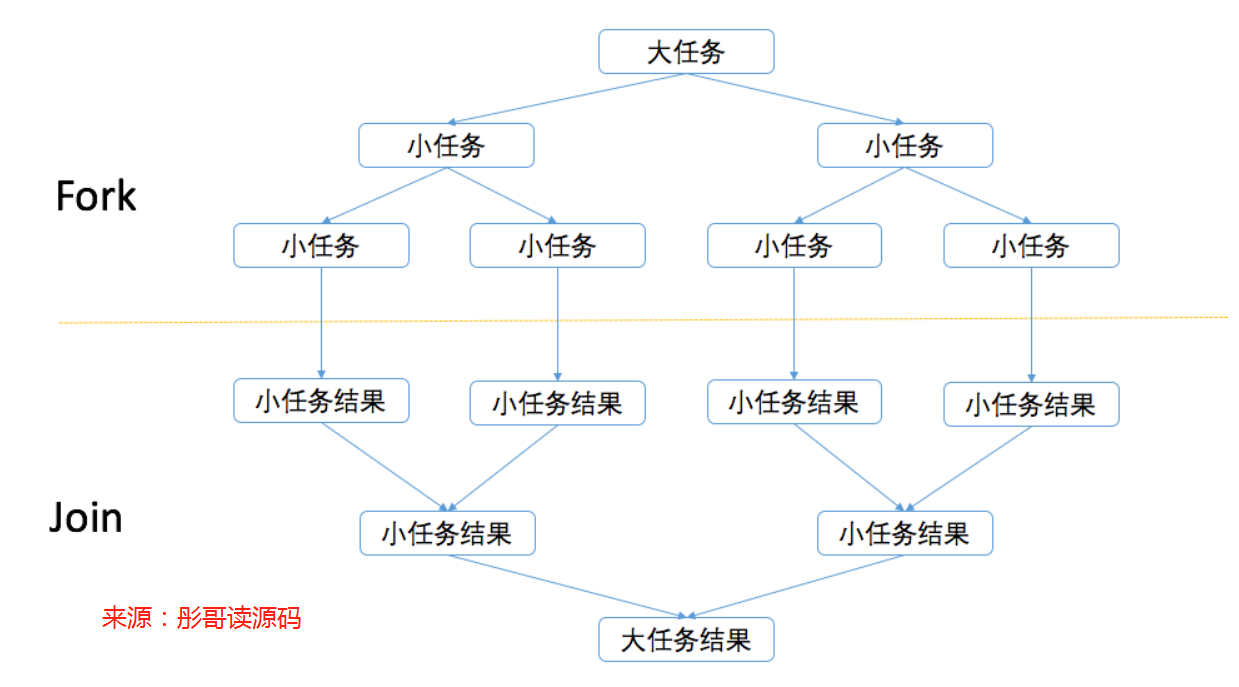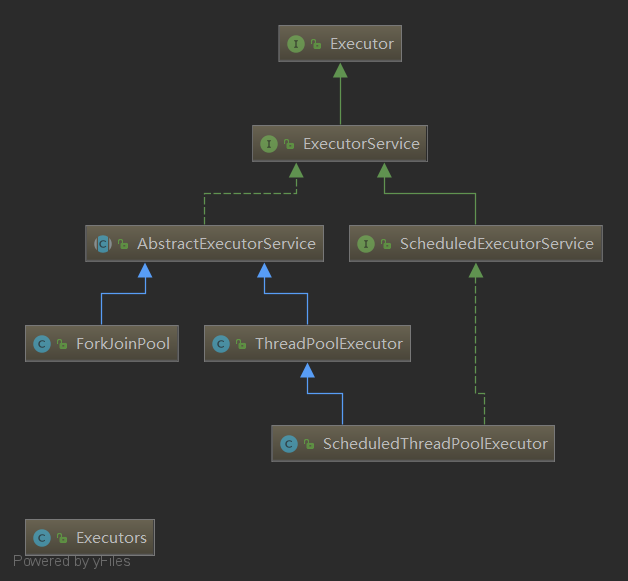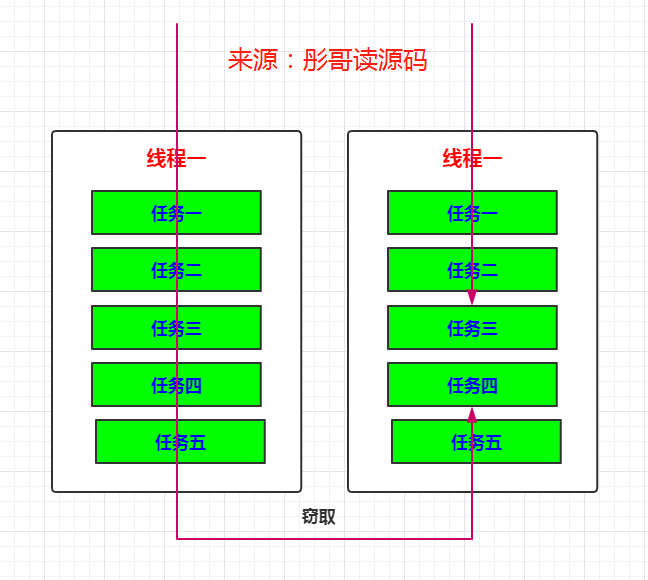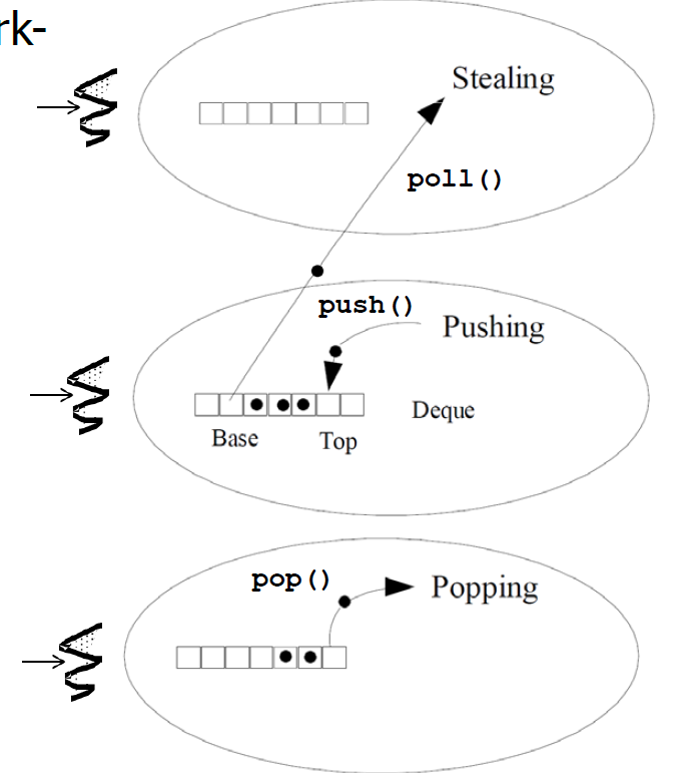死磕 java线程系列之ForkJoinPool深入解析

(手机横屏看源码更方便)
注:java源码分析部分如无特殊说明均基于 java8 版本。
注:本文基于ForkJoinPool分治线程池类。
简介
随着在硬件上多核处理器的发展和广泛使用,并发编程成为程序员必须掌握的一门技术,在面试中也经常考查面试者并发相关的知识。
今天,我们就来看一道面试题:
如何充分利用多核CPU,计算很大数组中所有整数的和?
剖析
- 单线程相加?
我们最容易想到就是单线程相加,一个for循环搞定。
- 线程池相加?
如果进一步优化,我们会自然而然地想到使用线程池来分段相加,最后再把每个段的结果相加。
- 其它?
Yes,就是我们今天的主角——ForkJoinPool,但是它要怎么实现呢?似乎没怎么用过哈^^
三种实现
OK,剖析完了,我们直接来看三种实现,不墨迹,直接上菜。
/**
* 计算1亿个整数的和
*/
public class ForkJoinPoolTest01 {
public static void main(String[] args) throws ExecutionException, InterruptedException {
// 构造数据
int length = 100000000;
long[] arr = new long[length];
for (int i = 0; i < length; i++) {
arr[i] = ThreadLocalRandom.current().nextInt(Integer.MAX_VALUE);
}
// 单线程
singleThreadSum(arr);
// ThreadPoolExecutor线程池
multiThreadSum(arr);
// ForkJoinPool线程池
forkJoinSum(arr);
}
private static void singleThreadSum(long[] arr) {
long start = System.currentTimeMillis();
long sum = 0;
for (int i = 0; i < arr.length; i++) {
// 模拟耗时,本文由公从号“彤哥读源码”原创
sum += (arr[i]/3*3/3*3/3*3/3*3/3*3);
}
System.out.println("sum: " + sum);
System.out.println("single thread elapse: " + (System.currentTimeMillis() - start));
}
private static void multiThreadSum(long[] arr) throws ExecutionException, InterruptedException {
long start = System.currentTimeMillis();
int count = 8;
ExecutorService threadPool = Executors.newFixedThreadPool(count);
List<Future<Long>> list = new ArrayList<>();
for (int i = 0; i < count; i++) {
int num = i;
// 分段提交任务
Future<Long> future = threadPool.submit(() -> {
long sum = 0;
for (int j = arr.length / count * num; j < (arr.length / count * (num + 1)); j++) {
try {
// 模拟耗时
sum += (arr[j]/3*3/3*3/3*3/3*3/3*3);
} catch (Exception e) {
e.printStackTrace();
}
}
return sum;
});
list.add(future);
}
// 每个段结果相加
long sum = 0;
for (Future<Long> future : list) {
sum += future.get();
}
System.out.println("sum: " + sum);
System.out.println("multi thread elapse: " + (System.currentTimeMillis() - start));
}
private static void forkJoinSum(long[] arr) throws ExecutionException, InterruptedException {
long start = System.currentTimeMillis();
ForkJoinPool forkJoinPool = ForkJoinPool.commonPool();
// 提交任务
ForkJoinTask<Long> forkJoinTask = forkJoinPool.submit(new SumTask(arr, 0, arr.length));
// 获取结果
Long sum = forkJoinTask.get();
forkJoinPool.shutdown();
System.out.println("sum: " + sum);
System.out.println("fork join elapse: " + (System.currentTimeMillis() - start));
}
private static class SumTask extends RecursiveTask<Long> {
private long[] arr;
private int from;
private int to;
public SumTask(long[] arr, int from, int to) {
this.arr = arr;
this.from = from;
this.to = to;
}
@Override
protected Long compute() {
// 小于1000的时候直接相加,可灵活调整
if (to - from <= 1000) {
long sum = 0;
for (int i = from; i < to; i++) {
// 模拟耗时
sum += (arr[i]/3*3/3*3/3*3/3*3/3*3);
}
return sum;
}
// 分成两段任务,本文由公从号“彤哥读源码”原创
int middle = (from + to) / 2;
SumTask left = new SumTask(arr, from, middle);
SumTask right = new SumTask(arr, middle, to);
// 提交左边的任务
left.fork();
// 右边的任务直接利用当前线程计算,节约开销
Long rightResult = right.compute();
// 等待左边计算完毕
Long leftResult = left.join();
// 返回结果
return leftResult + rightResult;
}
}
}
彤哥偷偷地告诉你,实际上计算1亿个整数相加,单线程是最快的,我的电脑大概是100ms左右,使用线程池反而会变慢。
所以,为了演示ForkJoinPool的牛逼之处,我把每个数都/3*3/3*3/3*3/3*3/3*3了一顿操作,用来模拟计算耗时。
来看结果:
sum: 107352457433800662 single thread elapse: 789 sum: 107352457433800662 multi thread elapse: 228 sum: 107352457433800662 fork join elapse: 189
可以看到,ForkJoinPool相对普通线程池还是有很大提升的。
问题:普通线程池能否实现ForkJoinPool这种计算方式呢,即大任务拆中任务,中任务拆小任务,最后再汇总?

你可以试试看(-᷅_-᷄)
OK,下面我们正式进入ForkJoinPool的解析。
分治法
- 基本思想
把一个规模大的问题划分为规模较小的子问题,然后分而治之,最后合并子问题的解得到原问题的解。
- 步骤
(1)分割原问题:
(2)求解子问题:
(3)合并子问题的解为原问题的解。
在分治法中,子问题一般是相互独立的,因此,经常通过递归调用算法来求解子问题。
- 典型应用场景
(1)二分搜索
(2)大整数乘法
(3)Strassen矩阵乘法
(4)棋盘覆盖
(5)归并排序
(6)快速排序
(7)线性时间选择
(8)汉诺塔
ForkJoinPool继承体系
ForkJoinPool是 java 7 中新增的线程池类,它的继承体系如下:

ForkJoinPool和ThreadPoolExecutor都是继承自AbstractExecutorService抽象类,所以它和ThreadPoolExecutor的使用几乎没有多少区别,除了任务变成了ForkJoinTask以外。
这里又运用到了一种很重要的设计原则——开闭原则——对修改关闭,对扩展开放。
可见整个线程池体系一开始的接口设计就很好,新增一个线程池类,不会对原有的代码造成干扰,还能利用原有的特性。
ForkJoinTask
两个主要方法
- fork()
fork()方法类似于线程的Thread.start()方法,但是它不是真的启动一个线程,而是将任务放入到工作队列中。
- join()
join()方法类似于线程的Thread.join()方法,但是它不是简单地阻塞线程,而是利用工作线程运行其它任务。当一个工作线程中调用了join()方法,它将处理其它任务,直到注意到目标子任务已经完成了。
三个子类
- RecursiveAction
无返回值任务。
- RecursiveTask
有返回值任务。
- CountedCompleter
无返回值任务,完成任务后可以触发回调。
ForkJoinPool内部原理
ForkJoinPool内部使用的是“工作窃取”算法实现的。

(1)每个工作线程都有自己的工作队列WorkQueue;
(2)这是一个双端队列,它是线程私有的;
(3)ForkJoinTask中fork的子任务,将放入运行该任务的工作线程的队头,工作线程将以LIFO的顺序来处理工作队列中的任务;
(4)为了最大化地利用CPU,空闲的线程将从其它线程的队列中“窃取”任务来执行;
(5)从工作队列的尾部窃取任务,以减少竞争;
(6)双端队列的操作:push()/pop()仅在其所有者工作线程中调用,poll()是由其它线程窃取任务时调用的;
(7)当只剩下最后一个任务时,还是会存在竞争,是通过CAS来实现的;

ForkJoinPool最佳实践
(1)最适合的是计算密集型任务,本文由公从号“彤哥读源码”原创;
(2)在需要阻塞工作线程时,可以使用ManagedBlocker;
(3)不应该在RecursiveTask<r>的内部使用ForkJoinPool.invoke()/invokeAll();
总结
(1)ForkJoinPool特别适合于“分而治之”算法的实现;
(2)ForkJoinPool和ThreadPoolExecutor是互补的,不是谁替代谁的关系,二者适用的场景不同;
(3)ForkJoinTask有两个核心方法——fork()和join(),有三个重要子类——RecursiveAction、RecursiveTask和CountedCompleter;
(4)ForkjoinPool内部基于“工作窃取”算法实现;
(5)每个线程有自己的工作队列,它是一个双端队列,自己从队列头存取任务,其它线程从尾部窃取任务;
(6)ForkJoinPool最适合于计算密集型任务,但也可以使用ManagedBlocker以便用于阻塞型任务;
(7)RecursiveTask内部可以少调用一次fork(),利用当前线程处理,这是一种技巧;
彩蛋
ManagedBlocker怎么使用?
答:ManagedBlocker相当于明确告诉ForkJoinPool框架要阻塞了,ForkJoinPool就会启另一个线程来运行任务,以最大化地利用CPU。
请看下面的例子,自己琢磨哈^^。
/**
* 斐波那契数列
* 一个数是它前面两个数之和
* 1,1,2,3,5,8,13,21
*/
public class Fibonacci {
public static void main(String[] args) {
long time = System.currentTimeMillis();
Fibonacci fib = new Fibonacci();
int result = fib.f(1_000).bitCount();
time = System.currentTimeMillis() - time;
System.out.println("result,本文由公从号“彤哥读源码”原创 = " + result);
System.out.println("test1_000() time = " + time);
}
public BigInteger f(int n) {
Map<Integer, BigInteger> cache = new ConcurrentHashMap<>();
cache.put(0, BigInteger.ZERO);
cache.put(1, BigInteger.ONE);
return f(n, cache);
}
private final BigInteger RESERVED = BigInteger.valueOf(-1000);
public BigInteger f(int n, Map<Integer, BigInteger> cache) {
BigInteger result = cache.putIfAbsent(n, RESERVED);
if (result == null) {
int half = (n + 1) / 2;
RecursiveTask<BigInteger> f0_task = new RecursiveTask<BigInteger>() {
@Override
protected BigInteger compute() {
return f(half - 1, cache);
}
};
f0_task.fork();
BigInteger f1 = f(half, cache);
BigInteger f0 = f0_task.join();
long time = n > 10_000 ? System.currentTimeMillis() : 0;
try {
if (n % 2 == 1) {
result = f0.multiply(f0).add(f1.multiply(f1));
} else {
result = f0.shiftLeft(1).add(f1).multiply(f1);
}
synchronized (RESERVED) {
cache.put(n, result);
RESERVED.notifyAll();
}
} finally {
time = n > 10_000 ? System.currentTimeMillis() - time : 0;
if (time > 50)
System.out.printf("f(%d) took %d%n", n, time);
}
} else if (result == RESERVED) {
try {
ReservedFibonacciBlocker blocker = new ReservedFibonacciBlocker(n, cache);
ForkJoinPool.managedBlock(blocker);
result = blocker.result;
} catch (InterruptedException e) {
throw new CancellationException("interrupted");
}
}
return result;
// return f(n - 1).add(f(n - 2));
}
private class ReservedFibonacciBlocker implements ForkJoinPool.ManagedBlocker {
private BigInteger result;
private final int n;
private final Map<Integer, BigInteger> cache;
public ReservedFibonacciBlocker(int n, Map<Integer, BigInteger> cache) {
this.n = n;
this.cache = cache;
}
@Override
public boolean block() throws InterruptedException {
synchronized (RESERVED) {
while (!isReleasable()) {
RESERVED.wait();
}
}
return true;
}
@Override
public boolean isReleasable() {
return (result = cache.get(n)) != RESERVED;
}
}
}
欢迎关注我的公众号“彤哥读源码”,查看更多源码系列文章, 与彤哥一起畅游源码的海洋。

- 死磕 java线程系列之ForkJoinPool深入解析
- 死磕 java线程系列之线程池深入解析——生命周期
- 死磕 java线程系列之线程池深入解析——普通任务执行流程
- 死磕 java线程系列之线程池深入解析——体系结构
- 死磕 java线程系列之线程池深入解析——体系结构
- 死磕 java线程系列之线程池深入解析——生命周期
- 死磕 java线程系列之线程池深入解析——定时任务执行流程
- 死磕 java线程系列之线程池深入解析——未来任务执行流程
- 【JUC源码解析】ForkJoinPool
- java多线程之ForkJoinPool
- 《Enterprise Library深入解析与灵活应用》博文系列汇总
- Fork/Join Framework Tutorial: ForkJoinPool Example
- Android实战技巧:深入解析AsyncTask与thread的区别 THREAD_POOL_EXECUTOR
- WPF快速入门系列(5)——深入解析WPF命令
- 玩转Google开源C++单元测试框架Google Test系列(gtest)之七 - 深入解析gtest
- ForkJoinPool
- JUC forkJoinPool
- [Joe 原创] Web Control 开发系列(二) 深入解析Page的PostBack过程和IPostBackDataHandler
- Cocos2d-x 深入解析系列 : 以XML文件方式保存用户数据--------------cocos2d-x3.0正式版本(7.13)
- 自动释放池的前世今生 ---- 深入解析 autoreleasepool
